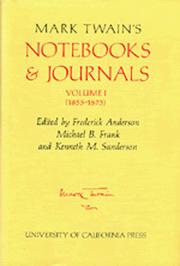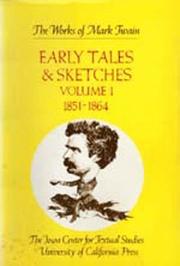| Listing 1 - 4 of 4 |
Sort by
|
Periodical
Year: 1925 Publisher: Willebroek Don Bosco Vrienden
Abstract | Keywords | Export | Availability | Bookmark
 Loading...
Loading...Choose an application
- Reference Manager
- EndNote
- RefWorks (Direct export to RefWorks)

ISBN: 0520023269 9786612355141 1282355147 0520905385 9780520905382 9780520023260 Year: 1975 Publisher: Berkeley London University of California Press
Abstract | Keywords | Export | Availability | Bookmark
 Loading...
Loading...Choose an application
- Reference Manager
- EndNote
- RefWorks (Direct export to RefWorks)
In the summer of 1855, when the nineteen-year-old Sam Clements traveled from Saint Louis to Hannibal, Paris, and Florida, Missouri, and then to Keokuk, Iowa, he carried with him a notebook in which he entered French lessons, phrenological information, miscellaneous observations, and reminders about errands to be performed. This first notebook thus took the random form which would characterize most of those to follow. About the text: In order to avoid editorial misrepresentation and to preserve the texture of autograph documents, the entries are presented in their original, often unfinished, form with most of Clemens' irregularities, inconsistencies, errors, and cancellations unchanged. Clemens' cancellations are included in the text enclosed in angle brackets, thus ‹word›; editorially-supplied conjectural readings are in square brackets, thus [word]; hyphens within square brackets stand for unreadable letters, thus [--]; and editorial remarks are italicized and enclosed in square brackets, thus [blank page}- A slash separates alternative readings which Clemens left unresolved, thus word/word. The separation of entries is indicated on the printed page by extra space between lines; when the end of a manuscript entry coincides with the end of a page of the printed text, the symbol [#] follows the entry. A full discussion of textual procedures accompanies the tables of emendation and details of inscription in the Textual Apparatus at the end of each volume; specific textual problems are explained in headnotes or footnotes when unusual situations warrant.
Authors, American --- Twain, Mark, --- Twain, Mark --- Tvėn, Mark --- Tuėĭn, Mark --- Tuwayn, Mārk --- Twayn, Mārk --- Tʻu-wen, Ma-kʻo --- Tven, M. --- Touen, Makū --- Twain, Marek --- Make Tuwen --- Tuwen, Make --- Make Teviin --- Твен, Марк --- Touain, Mark --- טבןַ, מרק, --- טוויין, מארק, --- טוויין, מרק, --- טווין, מארק, --- טווין, מרק, --- טווען, מארק, --- טוין, מרק, --- טװען, מארק, --- טװײן, מארק, --- 馬克吐温, --- Tuvāyn, Mārk --- Tvāyn, Mārk --- تواين، مارک --- Clemens, Samuel Langhorne --- Snodgrass, Quintus Curtius --- Conte, Louis de --- 19th century literature. --- american author. --- american literature. --- casual twain. --- classics. --- day in the life. --- everyday twain. --- hannibal. --- humor. --- juvenilia. --- literary criticism. --- marginalia. --- mark twain. --- missouri. --- nonfiction. --- phrenology. --- samuel clemens. --- satire. --- social commentary. --- travel writings. --- turn of the century. --- twain drafts. --- twains notebook. --- unpublished twain.

ISBN: 0520031865 9786612382895 1282382896 052090575X 9780520905757 9780520031869 9781282382893 6612382899 Year: 1979 Volume: 15 Publisher: Berkeley (CA) : University of California Press,
Abstract | Keywords | Export | Availability | Bookmark
 Loading...
Loading...Choose an application
- Reference Manager
- EndNote
- RefWorks (Direct export to RefWorks)
This collection brings together for the first time more than 360 of Mark Twain's short works written between 1851, the year of his first extant sketch, and 1871, when he renounced his ties with the Buffalo Express and the Galaxy, resolving to ";write but little for periodicals hereafter."; In October 1871 Clemens and his family moved to Hartford, where they would live until 1891. No longer a journalist, he was about to complete his second full-length book, Roughing It. The literary apprenticeship that he had begun twenty years before in the print shops of Hannibal, and pursued in the newspaper offices of Virginia City, San Francisco, and Buffalo, had at last come to a close. The selections included in these volumes represent a generous sampling from Mark Twain's most imaginative journalism, a few set speeches, a few poems, and hundreds of tales and sketches recovered from more than fifty newspapers and journals, as well as two dozen unpublished items of various description-the main body of what can now be found of his early literary and subliterary work, though by no means everything written during those twenty years of experimentation. The selections are ordered chronologically and therefore provide a nearly continuous record of the author's literary activity from his earliest juvenilia up through the mature work that he published in the Galaxy, the Buffalo Express, and many other journals.
LITERARY CRITICISM / American / General. --- Twain, Mark, --- Twain, Mark --- Tvėn, Mark --- Tuėĭn, Mark --- Tuwayn, Mārk --- Twayn, Mārk --- Tʻu-wen, Ma-kʻo --- Tven, M. --- Touen, Makū --- Twain, Marek --- Make Tuwen --- Tuwen, Make --- Make Teviin --- Твен, Марк --- Touain, Mark --- טבןַ, מרק, --- טוויין, מארק, --- טוויין, מרק, --- טווין, מארק, --- טווין, מרק, --- טווען, מארק, --- טוין, מרק, --- טװען, מארק, --- טװײן, מארק, --- 馬克吐温, --- Tuvāyn, Mārk --- Tvāyn, Mārk --- تواين، مارک --- Clemens, Samuel Langhorne --- Snodgrass, Quintus Curtius --- Conte, Louis de --- a duel prevented. --- advice to the unreliable on church going. --- american authors. --- american literature. --- an apology repudiated. --- buffalo express. --- carson city. --- classics. --- connubial bliss. --- dog controversy. --- galaxy. --- gallant fireman. --- hannibal. --- how to cure a cold. --- humor. --- journalism. --- juvenilia. --- literary criticism. --- mark twain. --- more ghosts. --- nevada. --- our stock remarks. --- pah utes. --- poems. --- religion. --- samuel clemens. --- satire. --- short fiction. --- short stories. --- social commentary. --- spanish mine. --- speeches. --- those blasted children.
Book
ISBN: 0691229813 9780691229812 0691198004 0691229805 Year: 2021 Publisher: Princeton University Press
Abstract | Keywords | Export | Availability | Bookmark
 Loading...
Loading...Choose an application
- Reference Manager
- EndNote
- RefWorks (Direct export to RefWorks)
A reexamination of Austen’s unpublished writings that uncovers their continuity with her celebrated novels—and that challenges distinctions between the writer’s “early” and “late” periodsJane Austen’s six novels, published toward the end of her short life, represent a body of work that is as brilliant as it is compact. Her earlier writings have routinely been dismissed as mere juvenilia, or stepping stones to mature proficiency and greatness. Austen’s first biographer described them as “childish effusions.” Was he right to do so? Can the novels be definitively separated from the unpublished works? In Jane Austen, Early and Late, Freya Johnston argues that they cannot.Examining the three manuscript volumes in which Austen collected her earliest writings, Johnston finds that Austen’s regard and affection for them are revealed by her continuing to revisit and revise them throughout her adult life. The teenage works share the milieu and the humour of the novels, while revealing more clearly the sources and influences upon which Austen drew. Johnston upends the conventional narrative according to which Austen discarded the satire and fantasy of her first writings in favour of the irony and realism of the novels. By demonstrating a stylistic and thematic continuity across the full range of Austen’s work, Johnston asks whether it makes sense to speak of an early and a late Austen at all.Jane Austen, Early and Late offers a new picture of the author in all her complexity and ambiguity, and shows us that it is not necessarily true that early work yields to later, better things.--
Austen, Jane, --- Criticism and interpretation. --- Amendment. --- Anna Maria Porter. --- Anne Elliot. --- Author. --- Book. --- Bree (Middle-earth). --- Cassandra Austen. --- Catholic Church. --- Charlotte Lennox. --- Claire Tomalin. --- Clarissa. --- Claudia L. Johnson. --- Correction (novel). --- Debut novel. --- Diary. --- E. M. Forster. --- Early Period. --- Edition (book). --- Elinor Dashwood. --- Eliza de Feuillide. --- Elizabeth Bennet. --- Elizabeth Bishop. --- Emma (novel). --- Emma Woodhouse. --- Emmeline. --- Epigraph (literature). --- Epistle. --- Essay. --- Evelina. --- Fairy tale. --- Fanny Hill. --- Fanny Price. --- Felicia Hemans. --- Fiction. --- Fictional universe. --- First Story. --- Frances Burney. --- G. K. Chesterton. --- Hannah More. --- Hester Thrale. --- Historical romance. --- Inception. --- Intention. --- J. M. Barrie. --- Jane Austen. --- Janet Todd. --- John Cleland. --- Jude the Obscure. --- Juvenilia. --- Lady Susan. --- Life and Letters. --- Literary genre. --- Literary modernism. --- Mansfield Park. --- Manuscript. --- Margaret Tudor. --- Maria Edgeworth. --- Marianne Dashwood. --- Marriage plot. --- Martha Lloyd. --- Mary Brunton. --- Mary Crawford (Mansfield Park). --- Mary Musgrove. --- Mary Russell Mitford. --- Mary Wollstonecraft. --- Memoir. --- Middle age. --- Miss Bates. --- Mrs. --- N. (novella). --- North America. --- Northanger Abbey. --- Novel. --- Novelist. --- Parody. --- Persuasion (novel). --- Poetry. --- Point of Origin (novel). --- Prediction. --- Preface. --- Publication. --- Regency novel. --- Routledge. --- Samuel Taylor Coleridge. --- Sanditon. --- Sense and Sensibility. --- Sentimental novel. --- Sequel. --- Sir Francis Drake (TV series). --- Susan Gubar. --- The Beautifull Cassandra. --- The Female Quixote. --- The History of England (Austen). --- The History of England (Hume). --- The Light of Day (Graham Swift novel). --- The Years. --- Waverley Novels. --- William Hone. --- Writer. --- Writing. --- England --- -Social life and customs --- Social life and customs
| Listing 1 - 4 of 4 |
Sort by
|

 Search
Search Feedback
Feedback About UniCat
About UniCat  Help
Help News
News